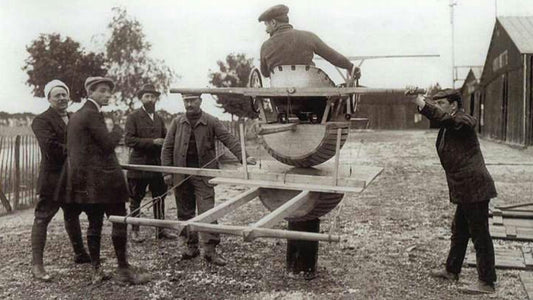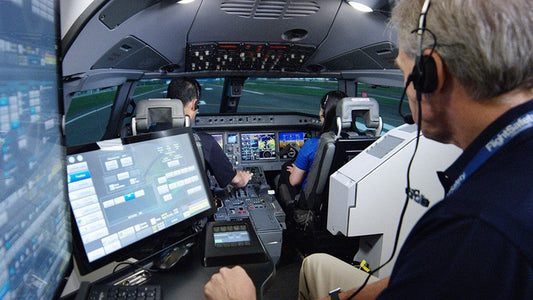The History of Flight Simulation – All You Need to Know

Do you know that the history of flight simulation dates way back to the early 1900s? While we all know about the jaw-dropping, beautifully designed Microsoft Flight Simulator and the classic DCS World, a thrilling top-notch combat simulator, there’s more to flight simulation than meets the eye.
From being incredibly pivotal to the success of the iconic Space Program in the 1960s to modern-day extensive training of commercial and military pilots, flight simulators have played a crucial role in the technological advancement of human civilization. Heck, they’ve even found their way into the gaming industry by spawning their own successful genre of video games.
As such, in this article, we are going to take a bit of a history lesson on flight simulators. Let’s get started!
A Bit of a Background (1900s – 40s)

However, all have not been so bright. The roots of flight simulators can be found in the wake of the World Wars, back when humanity was on the brink of destruction. The need for aerial supremacy put aviation manufacturers in a race to develop aircraft capable of successful flight.
As such, in 1909, Antoinette (a French aviation manufacturer) developed an early flight training device for instructional purposes. It was a mechanical ground-based trainer where instructors helped trainees understand basic flight control by simulating aircraft pitch and roll using physical force.
While it was short-lived due to its complex operation and lack of safety measures, the next major breakthrough came with Edwin Albert Link’s “Link Trainer” in the late 1920s—often called the "Blue Box." This was the first electromechanical flight simulator and saw massive success during World War II, with over 10,000 units used to train pilots.
Nevertheless, these early flight simulators were essentially simple devices that provided aspiring pilots with access to basic aircraft controls, such as tilt, pitch, and yaw, as well as familiarization with cockpit layout. They could not simulate motion or weather at this stage.
Transition to Civil Aviation (40s – 80s)

Now that both World Wars were over, flight simulation gradually seeped its way into civil aviation.
One of the first commercial flight simulators was the Boeing 377 Stratocruiser, a post-World War II commercial airliner that was known for its luxury and innovation during the late 1940s and 1950s. This ground simulator did not move, nor did it have any visual system (unlike the real Boeing 377), but the cockpit was the exact replica down to the last minute detail.
This was largely thanks to the advancements in electronics and the advent of analog computers that made it possible. Instructors could now include physical instruments that reacted to pilot inputs, which allowed for a more immersive and realistic flight simulation experience. Although it is nothing compared to the immersion we have today, it was a significant feat at the time.
Seeing the potential in flight simulators, both civil and military aviation began investing heavily in them. Flight simulators not only reduced training costs and provided a safe place to train, but they also started featuring full-scale cockpits, projected visuals, and a motion system as the technology improved. This only helped in more effective pilot training programs.
Rise of the Digital Computers (80s – 2000s)

Then, as digital computers came around in the 1980s, they quickly found themselves in flight simulators. Among many things, graphical displays replaced physical dials, and motion platforms became more dynamic and responsive. Previously, static visual backgrounds were used to provide a level of immersion to trainees, but now they have been replaced with computer-generated graphics.
This combination of computer-generated visuals and advanced motion platforms enabled simulations with six degrees of freedom, offering highly realistic visuals and immersive spatial cues for pilots in training.
During this time period, Full Flight Simulators (FFS) were developed and, particularly, in the military sector, they became an essential tool for pilot training. Increased computational power made it possible to simulate high-speed maneuvers and weapon systems with much greater accuracy.
Also, since the concept of home computers was now possible and the gaming industry was already booming, flight simulators also made their way into people’s homes. This was starkly different from those “physical” simulators employed by military and other civil departments. In that, these home simulators were basically “software” running on user computers. However, they featured realistic aviation mechanics to give players a true-to-life flying experience.

And as time would tell, software simulators will rise greatly in popularity and work in tandem with physical hardware flight simulators to deliver the most immersive flying experience without ever taking a real flight!
The very first example for this is “Flight Simulator” that was released for the Apple II by subLOGIC. It supported both the four-color and monochrome displays and was a marvel of its time. Then in 1982, Microsoft also released its “Microsoft Flight Simulator”. It emulated a Cessna 182 airplane and featured a control panel, eight gauges, twenty airports, simulated weather, and nine different POVs. “Flight Simulator II” soon followed and was released for the Apple II in 1983. It ran in a six-color mode and featured 80 airports and emulated the aircraft “Piper Archer”. Even disk expansions for the Flight Simulator II also got released.
Where the PC flight simulation scene was picking up momentum, handheld gaming consoles didn’t lag behind for long. Nintendo, in 1991, released Pilotwings. It was the most innovative, fun-to-play, and immersive of all the flight simulators released for consoles thus far. Pilotwings featured the humorous, unadulterated Nintendo-style fun while also staying true to realistic flight mechanics. It even produced two sequels later on, one for the Nintendo 64 and the other for Nintendo 3DS.
And just like that, we saw several other notable flight simulation releases, including but not limited to Ace Combat, Falcon 4.0, and Flightgear.
Widespread Adoption - The Role of AI, VR, & AR (00s – Present Day)

As technology matured, so did flight simulation. Not only did the hardware improve, but the software side of flight simulation also got better and better. Microsoft actually played a transformative role in bringing advanced flight simulation to consumer platforms, particularly with the launch of Microsoft Flight Simulator X in 2006. In its vast list of features, the flight simulator featured 24 highly detailed airports, over 38 highly detailed cities, support for 5.1 surround sound, as well as the “Shared Skies” multiplayer that allowed multiple users to fly together in the same cockpit.
These flight simulators have become so refined that even the world-renowned Regulatory Agencies like the FAA and EASA now require aspiring pilots to have spent time in simulation training. The combination of present-day hardware and cutting-edge flight simulations like DCS World and Microsoft Flight Simulation 2024 has made it possible to mimic a true-to-life flying experience and for pilots to prepare for every type of situation beforehand.
For example, VR headsets allow for a 360-degree environment with realistic cockpit interaction. AI-driven scenarios and augmented reality now let trainees practice emergency procedures and communicate in a highly engaging setting. Electric actuators that drive the full motion flight simulators have become so precise that they reproduce flight sensations with top-notch accuracy. Thanks to the internet, flight simulations now also incorporate real-time weather data, traffic updates, and voice interaction with simulated air traffic control. And just like that, networked simulations allow trainees to train together in joint or opposing roles. AI and machine learning let instructors track trainee performance and adapt training modules accordingly to better counter weak areas.
As seen above, all this immensely contributes to an immersive flight simulation experience. What started as a manual flight simulator device has evolved into this highly engaging flight simulation in a period of roughly 100 years. I wonder what the future holds for us. What do you think? Share your thoughts with us and let us know in the comments down below!





